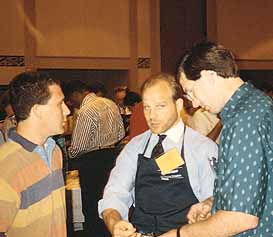
North America Spine Education Chairman Mitch Harris instructs at an AO course.
North American Spine Education Committee (NASEC)
By Mitch Harris, M.D., Chairman
The North American Spine Education Committee (NASEC) had its idealogic origin at an AO spine faculty retreat in October 1996. Its formal origin occurred approximately six months later as all five invited committee members accepted. Our first few meetings were aimed at establishing a mission statement and determining our primary objectives. Shortly after the initial meetings, we added a second neurosurgeon, and most recently we added a third neurosurgeon to expand the committee to seven.
This past year, the committee reviewed and revised the core lectures for the AO ASIF comprehensive spine course. This led to the creation of a set of objectives for each lecture, and these are currently distributed to the invited lecturers. The comprehensive course is now standardized in content, although each course chairman is given the prerogative to add specific lectures tailored to the course's honored guest lecturers.
 North America Spine Education Chairman Mitch Harris instructs at an AO course. |
The Spine Education Committee identified the need to expand our teaching faculty. This is currently being addressed, along with the establishment of specific criteria and a formal mechanism for application to become an AO Spine Faculty member.
The highlight of 1998 was the Spine Faculty Forum held in Tucson, Arizona, in October. This meeting allowed us to chart our path for the next year. After much discussion, it was decided to proceed with the creation of a resident's spine course, a course which will emphasize the principles of evaluation and the multiple treatment options for spinal disorders. This course will not be technique driven, and therefore, we hope to appeal to residents of orthopaedics, neurosurgery and physical medicine and rehabilitation. We have assembled a committee whose charge will be to formalize a curriculum, and it is our goal to have the first course in late 1999, or the first quarter of 2000.
We have also established working committees for trauma, degenerative disease, deformity, and cage technology/minimally invasive spinal surgery. The charge to these committees will be to actively review and improve the current lectures for the comprehensive and interactive courses, to assemble a "slide library" which will illustrate teaching principles for the 'firesides,' and to develop a plan for subspecialty seminars (11/2 days).
Additionally, once these committees are formed and mature, we hope to create a mechanism to initiate multi-center studies based at spinal centers directed by members of the AO spine faculty.
Finally, to ensure that we are headed in the appropriate direction, we have invited Dr. Ed Hanley to formally audit one of our courses this year. It is our hope that his unbiased evaluation will assist us in our goal to become the leading organization in spinal education, similar to the acknowledged excellence of the AO in trauma education.
Besides myself, the current members of the AO North American Spine Education Committee are Randy Chesnut, Cameron Huckell, Eric Woodward, Marcel Dvorak, Mike Janssen, and Seth Zeidman.